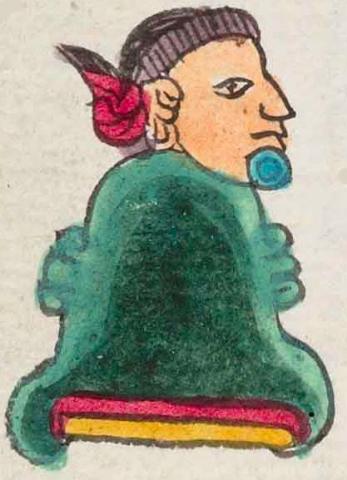Cempohuallan (Mdz21v)
This compound glyph for the place name Cempohuallan includes a silent hill or mountain (tepetl) (as a locative (representing -tlan, which goes to -lan when following a stem ending in -l) with the head of a man associated either with the number number 20 (cempohualli) or a specific ethnicity. Often the locative suffix -tlan is represented by teeth, but these are not shown here. The hill or mountain is the usual two-tone green bell shape, with rocky outcroppings on the sides and the yellow and red horizontal stripes at the base. The man has a short fringe of dark purple (meant to convey brown or black?) colored hair above his ear and forehead. His hair is bound with a red tie. There is a term for a red hair tie (tochacatl) that comes up in the Digital Florentine Codex, Book 8, f. 33v., sometimes translated as a cord or something like a candle wick. (See the Gran Diccionario Náhuatl.) The tip of the pony tail is pointing upwards. At the man's chin is a turquoise blue colored disc, probably a lip plug. In the digital collection TLACHIA, the three visual examples of a cempohualtecatl all have lip plugs. Here, the plug consists of two circles, one being smaller and concentric. The man's skin is a tan color. His head is in profile, looking to the viewer's right, and his eye is open.
Stephanie Wood
This man may be a tribute leader who oversaw twenty laborers or twenty households that were paying tributes (i.e. taxes in kind or in labor) to the local lord or to the colonial authorities. Michael E. Smith writes about the labor teams that were supposed to have twenty men, or at least that was the original concept. (See his contribution to the book, Fiscal regimes and the political economy of premodern states, 2015.) An alternate reading is that this was a Cempohualtecatl, a person of the Toltec kingdom of Tollan, something discussed by Miguel León-Portilla, as cited in our Online Nahuatl Dictionary entry for Cempohualteca. An iconographic study of the hair style and tie and lip plug might help settle the question. If so, this could be an ethnic indicator.
But, whatever the head of the person is meant to provide as a phonetic reading, the place name by itself seems to be Place of Twenty, or Place of the Twenty.
Stephanie Wood
çenpoalan. puo
Cempohuallan, pueblo (Zempoala, Hidalgo, today)
Stephanie Wood
c. 1541, or by 1553 at the latest
Stephanie Wood
twenties, veintes, tapones labiales, piel rojo, nombres de lugares

cempohual(li), twenty, https://nahuatl.wired-humanities.org/content/cempohualli
Cempohualteca, Toltec people of Tollan, https://nahuatl.wired-humanities.org/content/cempohualteca
-tlan (locative suffix), place, https://nahuatl.wired-humanities.org/content/tlan
"Place of Twenty" (Karttunen apparently agrees with the interpretation of Berdan and Anawalt) [Frances Karttunen, unpublished manuscript, used here with her permission.]
"Place of Twenty" (Berdan and Anawalt, 1992, vol. 1, p. 184; these authors spell the place name Çenpoalan))
Codex Mendoza, folio 21 verso, https://digital.bodleian.ox.ac.uk/objects/2fea788e-2aa2-4f08-b6d9-648c00..., image 53 of 188.
The Bodleian Libraries, University of Oxford, hold the original manuscript, the MS. Arch. Selden. A. 1. This image is published here under the UK Creative Commons, “Attribution-NonCommercial-ShareAlike 3.0 License” (CC-BY-NC-SA 3.0).
